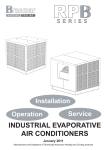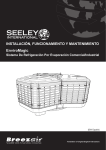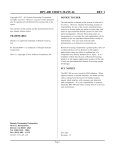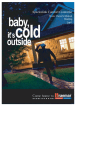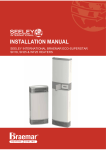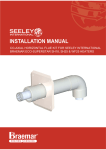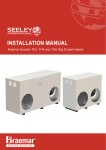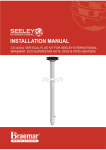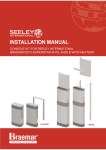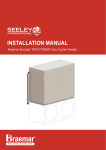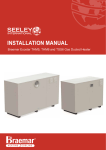Download Braemar Side Series Specifications
Transcript
RPC Evaporative Air Conditioning Owners Manual Installation, Operating & Service Instructions Down Series Top Series Side Series January 2009 Manufacturers and Designers of Technically Advanced Quality Heating and Cooling Products SERVICE: 1300 650 644 For all your Braemar warranty and service needs. Or Contact your local Braemar direct dealerr. TECHNICAL L SUPPORT CENTRE: 1300 650 399 For technical support regarding the installation of this product SALES: 1300 650 141 For all your sales enquiries Seeley International Pty Ltd has a policy of continuous product development and therefore reserves the right to make changes to these specifications without notice. Whilst every care has been taken to assure accuracy of the data compiled in the document, Seeley International Pty Ltd does not assume any liability for errors and/or omissions. www.seeley.com.au Manufacturers and Designers of Technically Advanced Quality Heating and Cooling Products ECN1550 Doc. No. 625409 /C Specialty Press xref0091 August 04 Braemar is a registered trademark of Braemar Industries Pty Ltd. Seeley International Pty Ltd ACN 23 054 687 035 Albury Manufacturing 77 North Street Albury, NSW 2640 COOLER DETAILS When ever you need to contact your Dealer regarding Service or Warranty please quote the unit Model number and Serial number as shown below. Model No................................... Serial No.................................. For your future reference: Air conditioner purchased from......................................................... Air conditioner purchase date ...... / ...... / ....... Phone No ....................... Air conditioner installed by............................................................... Air conditioner installation date Phone No ...................... ...... / ...... / ....... 1 CONTENTS SAFETY INFORMATION INTRODUCTION ~ Installation Recommendations And Procedures ~ Effective Cooling Requirements 2 3 3 INSTALLATION ~ Mounting The Cooler ~ Flexible Connector ~ Water Supply ~ Bleed Control ~ Bleed System ~ Water Manager (Optional) ~ Electrical Connection ~ Commissioning The Electronics (Variable speed only) ~ Setting The Motor Current ~ Pulley Adjustment ~ Motor Low Speed Setting ( Variable speed only) ~ Mounting Wall Control 4 5 6 6 7 7 8 10 11 12 14 15 WALL CONTROL FUNCTIONS ~ Starting Your Cooler ~ Automatic Mode ~ Manual Mode ~ Timed Automatic Start ~ Timed Automatic Stop ~ Using The Cooler ~ Air Too Cold ~ Air Not Cold Enough 17 17 18 18 19 19 19 19 TWO SPEED CONTROL FUNCTIONS ~ Two Speed Control INSTALLATION CHECKLIST COMPLETING THE INSTALLATION ~ Testing The Cooler ~ Clean Up The Site ~ Show Customer Their New Cooler 20 20 21 21 21 MAINTENANCE ~ End Of Season ~ Pre Season ~ Lubrication ~ Health Regulations ~ Replacing The Filter Pads ~ Service TROUBLE SHOOTING 22 22 22 22 23 23 24 2 SAFETY INFORMATION EMPLOYER AND EMPLOYEE RESPONSIBILITIES The installation and maintenance of evaporative air conditioning units, particularly at height, has the potential to create Occupational Health and Safety issues for those involved. Installers are advised to ensure they are familiar with relevant State and Federal legislation, such as Acts, Regulations, approved Codes of Practice and Australian Standards, which offer practical guidance on these health and safety issues. Compliance with these regulations will require appropriate work practices, equipment, training and qualification of workers. Seeley International provides the following information as a guide to contractors and employees to assist in minimising risk. Risk Assessment: A risk assessment of all hazardous tasks is required under legislation. A risk assessment is an essential element that should be conducted before the commencement of work. To identify and eliminate the risk of falls and other risks, or to minimise these risks by implementing control measures. This does not need to be a complicated process - it is a matter of assessing the job to be done and considering what action(s) are necessary so the person doing the job does not injure themselves. This should be considered in terms of: z z z What are the chances of an incident occurring? What could the possible consequences be? What can be done to reduce, or better still, eliminate the risk? Contact Technical Support Centre for an example of a Risk Assessment Form Some points to consider when working on or in a roof: z z z z z z z z z z z z Check State regulations regarding working at height. What is the best and safest access to the roof and working areas? What condition is the roof in? Should the roof structure and surface be checked? Does the worker have appropriate footwear? Are all power cables/extension leads safe and appropriately rated? Are all ladders, tools and equipment suitable and in good condition? Where ladders are to be used, is there a firm, stable base for them to stand on? Can they be tied or secured in some way at the top? Is there a roof anchor to attach a harness and lanyard to? If so, instruction should be issued for the use of an approved harness or only suitably trained people used Are all tools and materials being used, prevented from slipping and falling onto a person at ground level? Is the area below the work area suitably protected to prevent people entering this area? Does the work schedule take into account weather conditions, allowing for work to be suspended in high winds, thunder storms/lightning or other types of weather giving wet, slippery surfaces? Is there an on-going safety check system of harnesses, ropes, ladders and access/lifting equipment, and where they exist on roofs, anchor points before the commencement of work? Is there a system which prevents employees from working on or in roofs if they are unwell or under the influence of drugs or alcohol? Are there any special conditions to consider ie. excessive roof pitch, limited ground area, fragile roof, electrical power lines? Use the appropriate lifting equipment. THINK SAFE WORK SAFE INTRODUCTION 3 Congratulations on choosing a new Braemar cooler. Your cooler is built from the highest quality materials and engineered to provide many years of economical, trouble free cooling. Please take a few minutes to read these instructions so you have a full understanding of how to operate your cooler. Your installer should demonstrate the features and procedures set out in these instructions. The installer should also provide you with a Model and Serial Number which can be filled out in the section on the inside of the front cover. Keep these instructions in a safe place. All BRAEMAR air conditioners are operationally tested at the factory. Subject to normal handling in storage and transit, correct installation and operation, they will provide years of economical cooling with the minimum of service and maintenance. Braemar air conditioners are designed for a range of installations and are readily adaptable to the following applications. a. for connection to multiple outlet duct system b. for connection to a duct system for central air plenum diffusion. Installation Recommendations and Procedures. To ensure only fresh air flows through the filter pads, locate the cooler a minimum distance away from; a. Solid fuel type chimneys or flues - 3 metres b. Gas Heater flues - 1.5 metres c. Sewer or breather vent pipes - 5 metres Remember to check your local building code for the minimum distances in your area. Position the unit to allow access to the reservoir for plumbing fixtures and servicing. Thoroughly seal all roof penetrations, this will ensure storm water cannot enter the building as a result of the installation. Effective Cooling Requirements. To provide efficient cooling or ventilation your air conditioner must be operated with sufficient exhaust openings in the form of doors, windows, or other vents. One square metre of open area is the minimum requirement for every 3000 cubic metres per hour of air delivery. ( ie. A 6000 cubic metres per hr. air conditioner requires a minimum of 2 square metres of open exhaust areas ). For optimum cooling performance, windows opposite the prevailing wind conditions should be opened. The cool filtered air entering the house will flow toward the exhaust openings. Doors and windows should be set according to the airflow pattern desired. Air should never be re-circulated back through the air conditioner. When the design of the building or prevailing winds prevent effective airflow, consideration must be given to the use of some form of exhaust/extraction device. 4 INSTALLATION Important ! Installation must be in accordance with Municipal Building Regulations, Relevant Electrical Wiring Regulations, and any other relevant Codes and Regulations. All installation work to be carried out by Authorized Persons only. Mounting the Cooler These units have been designed to be directly mounted on top of a suitably sized and strengthened metal duct. Fixing is by means of self drilling screws or rivets through the steel mount on the bottom of unit to metal duct. 1 550 550 Dropper Flashing Roof Models RPC250, RPC320, RPC400 & RPC450 require a 550 x 550 square dropper. RPC ROOF MOUNTED DROPPER DETAILS FOR DOWN DISCHARGE MODELS. RPC "Side and Top" discharge units are required to be mounted onto a level platform and must be strong enough to support the unit under operating and prevailing conditions. 2 550 550 RPC ROOF MOUNTED FRAME TYPE DETAILS FOR "SIDE" & "TOP" DISCHARGE MODELS It is the policy of Seeley International to introduce continual product improvement. Accordingly, specifications are subject to change without notice. Please consult with your dealer to confirm the specifications of the model selected. 5 INSTALLATION Flexible Connector (Side & Top Series) FITTING INSTRUCTIONS The flexible connector has not been fitted at the factory. It is intended to be fitted on site to allow for better alignment to the ductwork. 1. Position the flexible connector (part A) with the seam to the bottom. The corners of the skirt will need to be slit approximately 20mm to prevent bulging at the corners. 2. The aluminium straps B,C,D & E fit inside the skirt. 3. Using one of the aluminium straps, mark and drill the rivet holes. Note - The bottom edge of the strap is intended to be level with the edge of the opening in the cooler. 4. Fit strap (part B) using the 5 of the rivets supplied, starting from the centre and working towards the ends. The skirt must be tucked under the aluminium strap before riveting. 5. Fit Straps C & D before fitting strap E. Seal with Silicone after completion. A 3 Top Edge A B 25 0 C D E A = Flexible Connector B = Top Strap C = Side Strap D = Side Strap E = Bottom Strap It is the policy of Seeley International to introduce continual product improvement. Accordingly, specifications are subject to change without notice. Please consult with your dealer to confirm the specifications of the model selected. B 6 INSTALLATION Water Supply Mains connection is made to the float valve fitted in the reservoir. The float valve must be set to maintain the reservoir water level about 10 mm below the overflow level. (Fig. 5). The mains water supply should be fitted with a ball valve and connection to the unit from the stopcock be made with the appropriate copper pipe and fittings. 4 D E F G C B H L A NOTE: Flush the mains supply before connection to the unit to remove any foreign matter which may foul the valve seat. Remember to use a Pipe Cutter to cut copper pipe. K A = Brass Nut B = Washer C = Brass Adaptor D = Plastic Elbow E = Plastic Nut F = Valve J I G = Float H = Overflow I = Tank J = Plastic Nut K = Threaded Bush L = O Ring (between H & K) Bleed Control To reduce the accumulation of salts and minerals in the cooler when running for long periods it is essential to bleed a certain amount of water. Increased flow of make up water reduces the salt content. The bleed rate will vary with the water supply quality, but should initially be set to the minimum recommended bleed rates as set out in Bleed System (page 7). If your water supply is of poor quality, higher bleed off rates are necessary to ensure reasonable pad life and cooler performance. Place the hose from the bleed tap into the overflow pipe. ( Fig. 6) Connect suitable pipe work to bottom of the overflow bush so that water drains directly to waste. Drain plumbing must be in accordance with local regulations 5 10 H I J K H = Overflow I = Tank J = Plastic Nut K = Threaded Bush 7 INSTALLATION Bleed System The bleed control tap is located externally on a corner pillar. Adjustment to the bleed rate is made by turning the black/red tap control to the desired setting. Check the bleed rate by running into a graduated container for a set time, say 10 minutes. 6 A = Bleed Tap B = Min/Max Label C = Corner Pillar D = Supply Hose from Pump E = Bleed Hose to Drain C B BLEED CONTROL A Max D Min E Recommended Bleed Rates Model lp10 min lph RPC250 1.2 7 RPC320 1.6 10 RPC400 2.0 12 RPC450 2.0 12 Water Management System (optional) An optional Water Manager Kit, Part # 073392, can be supplied with the cooler or at a later date if required. The water manager, which is fully automatic, is controlled by the CPMD electronics combined with your Braemar wall control. The system is designed to ensure that the water is always fresh, maintains your cooler in good condition and ensures optimum cooling performance. When the cooler is off for 72 hours, the drain valve will open automatically and empty water from the cooler. When the cooler is turned on again, fan operation will delay for a few minutes while the tank refills and the cooling pads are saturated again. At any time when the wall control is OFF, you can drain the cooler by pressing and holding S and T for 1 second. The display will show "dr" to confirm the operation has activated. Note: For Two Speed Coolers use KIT 098425 7 A B C D E F G ILL746-B A = Drain Valve B = Power Lead (plugs into control box) C = O-Ring D = Tank E = Nut F = Drain Adaptor G = Lock Nut 8 INSTALLATION Electrical Connection ¾ Mains Supply It is required that all units be connected to the mains supply through an independent circuit, suitably protected by fuse or circuit breaker. Ensure that the power supply is sufficient for the rating indicated on the serial plate. Wire the unit in accordance with all state and local regulations. 8 NOTE Mains cable must be double insulated if both mains and control cables are run in the same conduit. Please ensure that the hole in the reservoir and any penetration through the roof are adequately sealed with an approved sealant. ¾ Control Circuit Wiring z Variable Speed - 20 metre Low Voltage cable supplied with cooler. z Two Speed - Control circuit wiring is via a 240V 5 wire system. (not supplied) Cooler Controls Variable Speed - Braemar wall control with Auto/Manual z Two Speed - 240V Clipsal switch plate pattern. ¾ z ¾ Cooler Control Location z Variable Speed - It is advisable to locate the controller about 1.5 metres above the floor level in the room that will be lived in most. Avoid positioning the control in direct sunlight, an outside wall or near any heat source ( refrigerator etc. ), do not position in direct line with a cooling outlet. Placing the controller near a heat source or cooling outlet will effect its temperature readings. Two Speed - Place the control switch in a room or area that is the most convenient for you. z 9 INSTALLATION Electrical Connection ¾ Connection Down Discharge Units A hole is provided in the side of the blower housing for electrical entry. The mains lead and control cable are passed through this hole and wired to the control box. On installation pass the cables through the hole into the dropper and then into the roof cavity. 9 SERVICE CORD & LOOM FROM BASE OF COOLER z z Side Discharge Units Knock outs are provided on the outlet panel for mains and control cable loom. PASS PLUG AND CONTROL WIRING THROUGH GROMMET SCREW GROMMET TO THE DROPPER AS SHOWN COOLER CONTROL WIRING CONNECT PLUG TO OUTLET 10 Alternatively, entry can be made to the unit from beneath. The entry must be on the flat raised centre section of the tank above the water line and directly below the blower housing. Use only water tight fittings and thoroughly seal all entry points. z Top Discharge Units Entry for mains and control cable loom can be made through the cabinet Top. Alternatively, entry can be made to the unit from beneath. The entry must be on the flat raised centre section of the tank above the water line and directly below the blower housing. Use only water tight fittings and thoroughly seal all entry points. ∅ 50mm HOLE TO BE CUT INTO SIDE OF DROPPER 11 POWER OUTLET ATTACHED TO RAFTER BEAM 10 INSTALLATION Commissioning The Electronics Module (Variable Speed only) We recommend that you have a short test lead on hand for Coolers with a hard wired control system. You can then take the wall control to the roof and control the cooler from there. This will save you a lot of time. The short test looms are available from your Seeley spare parts distributor (P/No. 831534). Power up the cooler using the on / off switch on the Electronics control module. Test motor and pump operation. Look at the front of the module where two light emitting diodes (LEDs) are situated. The left LED is "Tricolour" and can glow green, red or amber. The right LED is red only. If the LED (fig 12 item G) is double flashing, everything is ok, this is normal operation. The following information allows quick diagnostics at start up. For more detailed information, consult the CPMD service guide. ¾ The "Tricolour LED" - acts as a general diagnostic indicator, and will function as follows. Green double flash every 2 seconds indicates the control is running normally. If it does not glow at all, then there is no power to the electronics module. (Check isolating switch, circuit breaker, plug and socket connection), or a failure has occurred. Red flashing indicates one or more of the following faults is present. 1 r ed f l a s h i ndi c a t es . . . . . . F a ul t code #1 - Communication failure 2 r ed f l a s hes i ndi c a t e. . . . . . F a ul t code #2 - Failure to detect water probes. (only for coolers with Solenoid, Probes and Drain Valve). 4 r e d f l a s he s i ndi c a t e . . . . . . F a ul t code #4 - Failure to clear probes during drain. (only for coolers with Solenoid, Probes and Drain Valve). 7 r e d f l a s he s i ndi c a t e . . . . . . F a ul t code #7 - Incorrect Supply Frequency ¾ The "Red" LED - indicates the status of the Water Manager measurement circuit and will function as follows. 1 f l a s h i n d i c a t e s . . . . . . . Water manager is operating and the measured salinity is below the set point. 2 f l a s h e s i n d i c a t e . . . . . . Water manager is operating and the measured salinity is above the set point. 3 f l a s h e s i n di c a t e . . . . . . The salinity control method = Drain every 65 minutes. 4 f l a s h e s i n d i c a t e . . . . . . Incorrect salinity control method selected. Cont i nuous l y On i ndi c a t e s . . . . . . The probes are in open circuit, or measured salinity is less than 20us/cm (the water is very pure, ie. has very little salt in it). 12 A C B D E F G H Connection Points A = Inlet Solenoid B = Drain Valve (or Shorting Plug) C = Wall Control D = Water Probes E = Fan Motor Minimum Speed Adjustment F = Pump G = Red Diagnostic LED H = Tricolour Diagnostic LED 11 INSTALLATION Setting The Motor Current Important! The motor pulley and belt tension need to be adjusted to ensure that the motor is running at its rated capacity. If the current is set to low, the cooler will not perform to its optimum capacity, and the motor speed control may not work effectively. The RPC two Speed units need to have full load amps checked on high and low speeds. Before setting the current please ensure that; 13 - The electronics module is fitted securely, and all leads have been connected correctly. - All ducting and registers are in place. - Windows and doors in rooms are opened sufficiently, and - All pad frames except the ones on the motor side and pulley side are in place. 1..... Run the motor at maximum speed by operating the cooler with the wall control set to MANUAL mode, maximum fan speed, ventilation only. WARNING! Ensure that the pump is not running. 2...... Continue running the motor for ten minutes (warms up the motor) before proceeding with the current measurement. During this period carry out general system checks including airflow, etc. 3...... Measure the motor current with a clamp meter. Attach the clamp meter around one of the motor cables as shown (fig 13). Compare the measured current with the rated current located on the motor. If the measured current is less than, or greater than the rated current, the adjustable pulley should be altered accordingly. Refer heading Pulley Adjustment. The measured current should be equal to, or within half an amp below that of the rated current. It must never be more than the rated current. Replace all covers and switch off clamp meter when adjustments are made. 12 INSTALLATION B A UT YO C EY IN D LL All RPC units are fitted with a variable pitch pulley so that the full potential of the motor can be utilised. The pulley is set at the factory to approximate the full motor load with the unit at free delivery. When installed and operating against system resistance, (with doors and windows open fully) adjustment may be made to the pulley in order that all the available power is utilised. 14 PUL LE Pulley Adjustment PU E ¾ Method of Pulley Adjustment Important! Never attempt this adjustment with the cooler operating. Pulley adjustment is made with the Cooler power isolated at the Electronics Module. F A = Fixed Sheave B = Motor C = Grub Screw D = Adjustable Sheave E = Locking Cap F = Locking Cap Fixing Screw 1..... Remove the drive belt. 2..... To adjust the pulley; Remove the securing screw that holds the locking cap in place. The adjustable half of the pulley is free to be adjusted by rotating it on its thread. (fig 14) 3..... To increase the blower speed and therefore increase the motor amps, the two halves of the pulley must be closer together, ie. turn the adjustable half clockwise (pulley in). 4..... To decrease the blower speed and therefore decrease the motor amps, the two halves of the pulley must be further apart, ie. turn the adjustable half of the pulley anti-clockwise (pulley out). 5..... When an adjustment is made; Replace the locking cap, aligning the screw hole with the nearest hole in the adjustable sheave. Lock it in place with the securing screw. Refit the drive belt (ensure tension is correct, ie. no slipping and not too tight, as this effects the motor current (fig 15) then check the amps 6...... Smaller adjustments should be made each time you approach the desired setting. Refer heading Belt Tension 13 INSTALLATION Belt Tension Note! This adjustment must be done immediately after the motor current adjustment has been completed. 15 A B C 15/20 mm Belt tension is important, if it is too tight there will be excessive belt and bearing wear. If belt tension is too loose there will be belt slip and excessive wear, accompanied with noise and loss of cooler performance. D E F A = Motor Pulley B = Motor C = Blower Housing D = Belt Tension Screw E = V Belt F = Blower Pulley Note! Adjusting belt tension is not the correct way to alter motor current, The current can only be altered by adjusting It is important to check the motor current the motor pulley. rating again after making any alterations to the belt tension. This may require a The belt tension should be adjusted so further adjustment to the motor pulley, that the maximum deflection is 15mm to which may have been slipping, giving 20mm when a reasonable force an incorrect reading. (approx..... 1.5kg) is applied. Two Speed Single Phase Wiring Diagram F US E B R OWN F US E A MA INS IN E 2 SPEED F AN MOT OR B R OWN LO HI C N OR ANG E 8 B R OWN 7 8 6 4 2 6 4 P OL E IS OL A T OR 5 1 B R OWN B LUE 3 B R OWN 5 RED WHIT E 7 B LUE DRAIN KIT COMPONENTS Electronics enclosure 4 PUMP FAN HIGH B R OWN B LUE 2 B R OWN E AR T H 1 E A N P UMP ACTIVE FAN LOW Drain Valve 3 9 10 11 12 NE UT R AL E AR T H * NE ON1 NE ON2 (V IE WE D F R OM R E A R ) Solenoid enclosure WIR ING INS T R UC T IONS 1 1 2 2 LO/HI F AN 1 C 2 C OOL E AR T H 1. T HE INC OMING MAINS P OWE R MUS T B E T AK E N DIR E C T LY T O T HE C OOLE R . 2. 5 WIR E S AR E R E QUIR E D B E T WE E N T HE C OOLE R AND T HE WALL S WIT C H . 3. F OR DR AIN K IT 099149 WIR ING INS T R UC T IONS S E E MANUAL S UP P LIE D IN K IT OR V IS IT OUR WE B S IT E www.braemar.com.au ALL F IE LD WIR ING IS S HOWN AS 14 INSTALLATION Motor Low Speed Setting (Variable Speed Only RPC coolers fitted with the Electronics Module and Variable Speed Wall Control, will function across a wide speed range. The minimum speed has been factory set, and should not require any adjustment under normal circumstances. However, some adjustment may be necessary to suit specific installations. 16 After you have set the motor current and belt tension correctly, check the speed variation of the cooler. When the control is changed from maximum to minimum settings, there should be an easily recognizable difference in fan speed. If not, check the following; 1.... That windows and doors are open. Rule of thumb is to have 2 times the area of the outlet grille open for exhaust in each room. 2..... The weather damper is able to move freely (where fitted). If the above are all correct then proceed as follows. 3..... Set the fan speed to minimum using the wall control, so that only one bar is displayed. 5..... Turn the minimum speed adjustment knob clockwise or anti-clockwise, until the belt is running at approximately one revolution per second (this equates to a fan speed of approximately 600 rpm). The fan will give a burst on start up to open the weather damper (where fitted). Switch the fan off then on again, to ensure that the fan spins fast enough to open the weather damper and keep it open. It is important to allow the cooler to run for a while on minimum speed, to ensure the weather damper remains in the fully open position. 15 INSTALLATION Mounting the Variable Speed Wall Control 17 When selecting a position for the wall control, avoid the following locations: Direct sunlight An outside wall Any heat sources (eg. refrigerator, heater etc.) A position in direct line of a cooling outlet Mounting the wall control in a position near any heat source or cooling outlet will affect its ability to control temperature. It is advisable to locate the wall control about 1.5 metres above the floor level in the room that is used or most lived in. Plaster Board To mount the wall control on a plaster board wall, use the controller cradle as a template, and drill a 20mm hole (Fig 18-1) for the low voltage cable and 2 10mm holes (Fig 18-2)for the mounting hooks. Insert mounting hooks into the holes(Fig 19). 18 Cradle 2 1 19 20 Align and screw the cradle into position. Cradle 16 INSTALLATION Mounting the Variable Speed Wall Control Pull the low voltage cable through the large hole and plug it into the wall control. Feed the excess cable back into the hole and seal. Slide the wall control over the protruding bracket tabs. Pull the wall control down so that the bracket tabs engage with the keyway slots on the back of controller 21 22 Plaster Board 23 To mount the wall control on a brick wall, follow the previous instruction using the wall plugs and screws provided. Note that the wall plugs require a 6mm hole. Brick 17 WALL CONTROL FUNCTIONS Starting Your Cooler 24 The POWER button turns the cooler on and off. There are two modes of operation to choose from, Automatic mode or Manual mode. When the cooler is turned on, it will start in the mode of operation it was in when last turned off. If your cooler has not been operated for a while, then when you start it, "Pre Cool Cycle" may sometimes flash on the display as shown. This indicates that the water pump will operated to saturate the cooling pads for a few minutes before the fan is turned on. This is to ensure that when the fan starts, only cool air enters the building. Automatic Mode 25 The AUTO button switches between Automatic mode and Manual mode. When "Auto" is displayed the cooler is under Automatic control and will operate to the temperature sensed at the wall control. When the cooler is turned on, it will read the temperature and set the cooler operation accordingly. If the temperature increases at the wall control, then fan speed will increase. As the temperature decreases the fan speed will decrease until the cooler turns off. ILL1085-A 26 AUTOMATIC MODE DISPLAY Press S or T to override the automatic cooling level setting and adjust your room temperature. ILL1096-A 18 WALL CONTROL FUNCTIONS Manual Mode To switch to Manual mode, press AUTO until "Man" appears in the display. In Manual mode the cooling level can be manually adjusted. In Manual mode, press COOL to choose between circulating cool air or fresh air. When "Cool" is displayed, fresh cool air will circulate into the building. When "Vent" is displayed as shown (fig 28), fresh air will circulate through the building. 27 MANUAL MODE DISPLAY ILL1097-A 28 Press S to increase the fan speed and circulate more air. Press T to decrease the fan speed and circulated less air. Press once to change the speed by one increment. Hold the button down to change the speed more. Timed Automatic Start You can set the cooler to turn on after a set number of hours. 1. To set the delayed start time, press TIMER with the cooler turned OFF. "Starting in" will be displayed as shown (fig 29) with the last mode of operation (Automatic or Manual). ILL1098-A 29 2. If you want the cooler to turn on in Automatic mode with the previous settings, then press AUTO until "Auto" is displayed. Alternatively, if you want the cooler to turn on in Manual mode, press AUTO until "Man" is displayed and then press cool and then S or T to set the required fan speed. 3. To set the time until the start, press TIMER. 4. Then press S or T to adjust the time. The cooler can start up to 24 hours in advance. 5. Press TIMER again to initiate the timed automatic start. The timed start will not repeat. ILL1136-A 19 WALL CONTROL FUNCTIONS Timed Automatic Stop You can also set the cooler to turn off after a set number of hours. 30 1. To set a delayed stop time, press TIMER with the cooler running. "Stopping in" will display. 2. Press S or T to adjust the number of hours before the cooler will stop. The maximum delay setting is 24 hours. ILL1137-A 3. Press TIMER again to begin timed stop. Using The Cooler Now that you have read these instructions, press the POWER button to turn your cooler on. If the cooler has not operated for a while "Pre Cool Cycle" will flash on the display. The "Pre Cool Cycle" will begin and will take only a few moments to complete. After this time, the fan will come on automatically, and you can enjoy the comfort of cool fresh air. Air Too Cold With the cooler running in automatic mode, you may find that you are too cold or that the cooler is blowing too much air. Press T to lower the automatic temperature setting and reduce the amount of cooling. If you are to cold with the cooler running in Manual mode, then press T to reduce the fan sped. You can also circulate uncooled fresh air by pressing COOL until "Vent" displays. Air Not Cold Enough You may find that with the cooler running in Automatic mode, that you are not cool enough. Simply press S to increase the cooling rate. If you are not cool enough with the cooler running in Manual mode, then press S to increase the fan speed. Ensure that cooled air is circulating by pressing COOL until "Cool" is displayed. TWO SPEED CONTROL FUNCTIONS 20 Two Speed Control - Turn on the water at the source and ensure that any shut off valve is open. - Turn on the electrical supply and the mains isolator at the air conditioner. - Wait for the tank to fill with water. - Turn on the pump by switching the Cool switch on the wall control to Cool. - Wait 2 - 5 minutes for the pads to saturate with water. - Select either High or Low fan speed. - Turn on the fan by switching the Fan switch to ON. Installation Checklist TO BE COMPLETED BY THE COMMISSIONING AGENT 1. Unit level on mounting platform / dropper. 2. Unit correctly flashed to prevent water damage. 3. Check operation of weather damper (where fitted). 4. Tong test completed...................................... Amps _____ 5.“ V “ belt alignment and tension checked 6. Minimum speed correctly set. (variable speed only) 7. Unit wired in accordance with regulations and operating correctly. 8. Water main flushed before connection to unit. 9. Float valve set correctly. 10. Water flow adequate to all pads. 11. Bleed rate set and bleed hose positioned in overflow (drain valve where fitted). 12. Filter pads checked. 13. Water distribution through pads uniform. 14. Variable Speed Controller tested. Dealer Name Pump only running High Speed Fan only ................................................ High Speed Fan and Pump running Commissioned By Low Speed start-up Low Speed running ................................................ 15. Unit tested for maximum current. 16. Air flow from duct outlets correctly set. Date ......../......../......... 17. Adequate exhaust openings provided. 21 COMPLETING THE INSTALLATION 31 Testing The Cooler Once you are satisfied that the Cooler is installed and commissioned correctly, it is important to run the cooler and ensure that everything is working as it should. Check that the unit runs quietly and with an even distribution of air to all outlets. Make sure there are no water leaks. Where fitted, initiate a drain of the tank by pressing the S and T buttons together for 1 second when the controller is OFF. The signal "dr" will display to confirm the drain has activated. Clean Up The Site Clean up and tidy the premises, removing or recycling all rubbish. Your aim should be to have the customer not even aware that you have been there, apart from having their new Braemar installed to enjoy. 32 Show Customer Their New Cooler This is a good time to explain the features and principles of Evaporative Ducted Cooling to the new owner. Explain the wall control operation, how to exhaust the premises, and how to best run their cooler. Please take a few moments to explain to the customer: 33 • How far windows need to be opened. • How to turn the unit On. • Explain the preparing to start mode. • How to operate the cooler manually. • How to operate the cooler in vent mode. • How to operate the cooler in Auto mode. • How to drain the cooler (where fitted with drain valve). • How to turn the power and water off. • Maintenance requirements. Present the customer with their warranty card for their attention. Present the customer with this manual, and encourage them to keep it for future reference. MAINTENANCE 22 End of Season Maintenance • Turn off the water supply. • Remove filter pad frames. • Turn off the power at isolating switch inside cabinet. • Hose both sides of the filter pad frames to remove dust, salts pollen etc. If pads are deteriorating replace as required. • Check and clean the water distributor channels. • Empty the water reservoir through the outlet provided. Thoroughly clean the reservoir. Do not replace the outlet. • Ensure that water is not carrying over onto the motor. • Check Pulleys and Belts for wear. Check alignment and tensioning. Replace or adjust if necessary. • Switch on Isolating switch and refit pad frames. Pre-Season Maintenance • Remove the filter pad frames. • Turn off the Isolating switch • Replace drain outlet removed at the end of the season maintenance. • Turn on the water supply. Check the float valve assembly for correct operation and setting of water level ( refer to fig. 5). • Switch on the Isolating switch. • Refit the pad frames. •Run air conditioner for a period of time, check pads for an even saturation of water. •Check the bleed off rate and set using rates on page 7 as a guide. Lubrication Bearings on blower shafts, electric motors and water pumps are sealed for life and do not require lubrication. Health Regulations Please note that some state Regulations require that Evaporative Air Conditioners used for Commercial purposes are to be serviced at specific Intervals. Owners of Commercial Air Conditioners should contact the Health Authority in their state for servicing guidelines. MAINTENANCE 23 Replacing the Filter Pads If, during your Pre-Season or End of Season maintenance you determine that the filter pads need replacing, you will be able to purchase replacements from you local Dealer. Replacing the pads is as follows. • Switch off the air conditioner. • Remove the pad frames from the air conditioner by turning the black latch at the top of the pads, tilting the pad forward and lifting. • Chillcel® Pads - On a suitable work surface area, remove the rivets from the top of the frame, lift off the top frame, the water tray and pad will lift out. • Wood wool Pads - On a suitable work area, remove the rivet(s) securing splash guard to top of pad frame, open the wire frame and remove the pad. • Using a high pressure spray nozzle on a garden hose, wash any dirt and salt deposits from the louvre grille and frames. • Place the new pad into the frame and secure as before. When replacing pads with wood wool, ensure that the wood wool is distributed evenly throughout the frame and any protruding strands are pushed back in. Particular attention should be paid to the corners and edges so that air cannot bypass the pad. • Spray the assembly with water to rinse any dust or loose material from the frames, then install into air conditioner. DO NOT USE HIGH PRESSURE. • Switch the COOL control “ ON “, and check that the trough in the upper part of the pad is filling, and allowing the water to drain through the holes in the trough. NOTE. New filter pads can take some time to become conditioned and uniformly saturated when water is first applied. A characteristic odour of wet timber may be experienced during this period. Service To ensure that your Braemar Evaporative Air conditioner remains in first class working condition for many years, it should be thoroughly serviced twice a year. These Services should be performed at the end of the summer season and prior to the commencement of the next summer season, by an authorised Braemar Service Agent. Service phone number is on the back of this book 24 TROUBLE SHOOTING PROBABLE CAUSE SUGGESTED REMEDY • Inadequate Cooling Insufficient air discharge openings. Inadequate exhaust for area being cooled, causing high humidity and discomfort. Undersized air conditioner. Ducts blocked or collapsed Clogged or dirty filter pads. Dry pads or lack of water while the air conditioner is operating. Excessive Ambient Humidity. (see also top of page) Fan running too slowly. Belt slipping. Make sure adequate openings are provided to exhaust the incoming cool air. Open windows, doors etc. Replace with larger Model. Repair Ducts Clean or replace pads. Check water distribution system for obstructions. Check pump is operating. During summer when the humidity is high, the unit will not work as effectively.Turn the pump off and run in vent mode Check motor amps. If below rating plate specification, adjust motor pulley to increase fan speed Tighten belt. Replace if worn. • Fan Fails To Start Circuit breaker tripped or fuse blown. Overload tripped. Power not turned ON Loose electrical connections. Faulty control switch. Motor burned out. Reset or replace. Reset & check motor amps and adjust if necessary. Turn power ON Check all connections. Replace. Replace. • Motor Overheats & Trips Overload. Low supply voltage. Incorrect settings on current overloads. Consult with local Electrical Authority. Reset overloads to correct setting. Wrong motor size. Fan speed too high. Fit correct size motor. Adjust motor pulley until the motor current is equal or below that specified on motor rating plate • Belt Slipping / Wearing Excessively Belt loose. Pulleys out of line. Worn belts. Worn pulleys. Tighten belt. Align pulleys. Replace belts. Replace pulleys. • Pump runs but does not circulate water or pads lack water Insufficient water in tank causing pump to cavitate. Pump strainer clogged or dirty. Blocked water supply tubing. Adjust float level to increase water depth. Clean strainer. Clean out water trough.



























